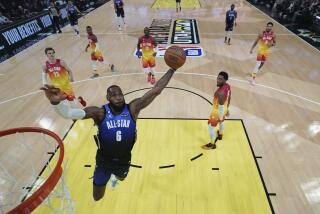Down-to-Earth Success : Pro basketball: Fundamental skills have kept Crespi High’s Paul Mokeski in NBA for 11 seasons.
- Share via
Michael Jordan soars like an eagle.
Magic Johnson performs the unimaginable with a basketball nearly every night.
Dominique Wilkins never met a backboard that he couldn’t look down on.
And Paul Mokeski? Wow! Does he take up a lot of space, or what?
While the marquee players in the NBA take the game into the rafters with their breathtaking ability to leap, others stay low during the aerial circuses. Big guys. Size of mature wildebeests, some of them. Guys whose feet seem to be in constant contact with the floor. Guys who, when a coach barks at them to jump, definitely do not ask how high.
Guys like Mokeski.
“I watch these guys flying above the rim all the time and I wish I could fly too,” said Mokeski, a former star at Crespi High and Kansas who is in his 11th NBA season. “I know it would be a nice feeling, up above the traffic. But I don’t miss it because I never knew that feeling.”
The feeling Mokeski has known in more than a decade of pounding in the NBA is that sharp feeling of an elbow slammed against his ribs. Or face. Or that priceless feeling of taking a full-force charge by Karl Malone or Akeem Olajuwon or any of the dozens of muscle mountains who claim the paint as their residence.
For his willingness to absorb such punishment, the 7-foot, 280-pound Mokeski has been rewarded with torn knee cartilage, a separated shoulder, seven fractures of his nose, two broken ribs, two broken ankles, bone chips in both elbows and back problems that come with a lifetime guarantee.
“Other than those things, I’ve never really been hurt,” Mokeski said, smiling.
He can smile, of course, because there have been other rewards for his suffering. First and most important, he makes it clear, have been the paychecks. Big paychecks. Huge paychecks. Mokeski makes more money in a season than the average worker will make in a lifetime.
That’s what happens when a youngster hears a coach tell of the importance of blocking out under the backboard and believes him. For if Mokeski’s NBA career has not been highlight-film material, if only seldom can one slip an envelope between his sneakers and the hardwood, it has been a classic study in the fundamentals of the trench game.
Of course, being only slightly smaller than Lapland is not exactly a drawback for such a job either.
At Crespi, Mokeski had grown to his present height by his senior season in 1975. In that season Mokeski led the Celts to their finest season. The team reeled off 17 consecutive victories, although its bid for the Southern Section 4-A Division championship was halted in the quarterfinals by Inglewood, which was led by another NBA veteran-to-be, Reggie Theus. Crespi finished that season a sterling 25-2.
At Kansas, Mokeski was among the team’s top five scorers in three of his four seasons. In the 1977-78 season, he helped the Jayhawks to a 24-5 record and the Big Eight championship.
In stints with the Houston Rockets--who made Mokeski the 42nd overall pick in the 1979 draft--the Detroit Pistons, the Milwaukee Bucks and now, for the second time in his career, the Cleveland Cavaliers, Mokeski has averaged 4.1 points and 3.5 rebounds a game. In his best season--1980-81 with the Pistons--he averaged 7.1 points and 5.2 rebounds.
One doesn’t need a detailed study to conclude that Mokeski hasn’t stayed in the NBA for 10 1/2 years because of his ability to get the basketball or to do something with it when he has it. His general orders have always gone something like this: “If you do somehow get the ball, immediately give it to someone wearing a similar-colored uniform.”
No, Mokeski has survived in the NBA mainly for one reason, an unspoken motto for his opponent that he has clung to like wool to a sheep: If I’m not getting this rebound, you aren’t either.
“My game is fundamentals,” Mokeski said. “I know what I can do and what I can’t do. One of the things I can do is block out, keep my guy away from the basket. That doesn’t always sound like much, but it’s important to a team. Very important.”
Obviously. He has not been out of work in more than a decade.
“When I came out of college I set a goal,” he said. “I wanted to play in the NBA for 10 years. I figured that would be enough. Not many people even gave me much of a chance to play any games in the NBA. I had no spectacular numbers in college. But after my junior year at Kansas, I knew I could play in the NBA.”
After one season in Houston, where he played sparingly behind a young and nearly unstoppable Moses Malone, Mokeski was traded to Detroit. He was playing about 25 minutes a game and turning in some solid defensive performances against the league’s million-dollar centers.
“In Houston, I still had a few doubts about how long I would last in the NBA,” he said. “But after that season in Detroit, I knew I could play on that level. And I knew I was getting better. A lot of guys who come into the NBA never get any better than they are in their first season. They hit their peak in college. I got better every year. I look at some of the guys in the league who are so physically talented . . .
“I consider myself a very good basketball player, one of the best in the world, because I’ve played in the NBA. But I’m certainly not as physically talented as most of these guys I play against. I know that. I’m not stupid. But I knew what I’d have to do and I knew what my place would be in this league.”
Mokeski, 33, knows the end of the NBA road is nearing and said he would like to play for two more years and then try broadcasting. His knees are sore these days, and he knows they likely will never feel much better. He hopes they don’t get much worse. But he also knows a limp might be a lifetime reminder of his days in the NBA.
“I worry about what I might be like 20 years from now,” he said. “I look at guys like Bob Lanier, who went through so many knee injuries, and I see how he walks and it worries me. I see a lot of guys like that who played in the NBA.
“But even at that price, it’s been worth it. I enjoy basketball so much. It has been my life. I can’t imagine one day not playing the game and not being around it.”
More to Read
Go beyond the scoreboard
Get the latest on L.A.'s teams in the daily Sports Report newsletter.
You may occasionally receive promotional content from the Los Angeles Times.










